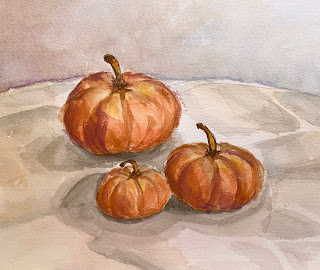An intelligent plan—not some mysterious quality called ‘talent’—is the basis of all successful painting.
 |
| Samantha’s finished monochrome painting. |
If my students don’t finish their paintings in class, I invite them to email me pictures later. Last week, they painted pumpkins, a project which turned into a delightfully idiosyncratic exercise.
Samantha East takes my Zoom class along with her husband, Lloyd. They started as beginners and were feeling pretty intimidated by some of the other students. This week, she sent me her painting along with a very lucid description of how she fixed it. I am sharing it with you:
“I was really pretty stuck at the end of class. When I sat down today, I had a plan but again felt pretty stymied right from the start. After a few failed efforts I realized the real problem is that I was trying to figure out color mixing, values, depth and shading, and how to deal with translucent paints all at the same time. Forget even thinking about focal points and diagonal lines & triangles. That’s just way too much for me to sort through all at once.
 |
| Samantha’s first drawing |
“Currently I’m really wanting to get a grip on depth and shading, so I decided to eliminate all the other puzzle pieces by reducing my palette to black and white. I redid the pencil drawing.
“Admittedly it’s not much different or better than the first but I spent a lot of time trying to really see what I was looking at and to understand it. Taking the time to do that was definitely worthwhile. I used a B&W version of the color photo above to help me see shadows and depth and value.
“It’s a tricky thing getting one’s brain to see things in a new way, in a new light… literally, in this case. It’s like learning to see again, all the while ignoring the short-cut version your brain created decades ago as in, ‘Yeah, yeah, it’s a squash and a pumpkin… move on, nothing to see here.’
 |
| Samantha’s first painting. She realized she was juggling too many elements, so she backed off the color. |
“In my search for what works I ended up with two different approaches between the squash and the pumpkin which was an interesting learning event for me. I also think it made for a more interesting painting.
“It’s a tricky thing to get on canvas what’s in my head. My brain understands but somehow that’s not what comes out of the brush. I feel like I’m actually in the business of building brand-new neural pathways, and once those are in place, I’ll be able to do new and increasingly interesting things. How totally cool is that?”
Samantha:
- Identified the problem as one of value (it almost always is);
- Deconstructed the process and added a step—looking at a b/w photo—to help her see what she was missing;
- Slowed down and really looked, rather than relying on what she thought she knew;
- Redid her value drawing;
- Mixed up her brushwork to add interest and texture.
Samantha is what we used to call One Smart Cookie. She’s got engineering and space degrees and flew for the Air Force for 24 years. I like teaching engineers, because they’re used to thinking about process. They don’t suffer from the bias of thinking that painting is an intuitive gift.
 |
| Samantha’s second drawing. Notice that she didn’t spend time on the extraneous matter; she’d already done that. She went to the heart of the shading question on the gourds themselves. |
Many great artists can’t tell you their process, but I assure you they all have one. I teach a very ordinary method; it’s an amalgam of tips and tricks used by artists over the centuries. It’s by no means the only process, but it’s time-tested and it works. Whatever method you choose, intelligent process—not some mysterious quality called ‘talent’—is really the basis of all successful painting.







